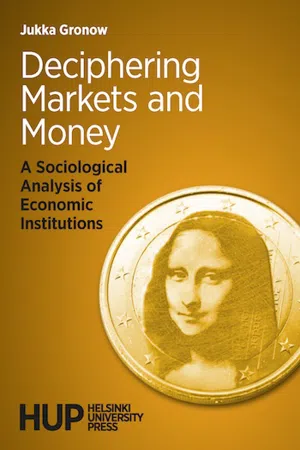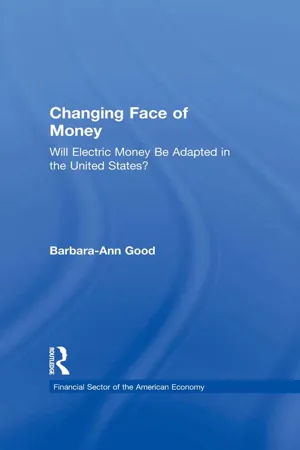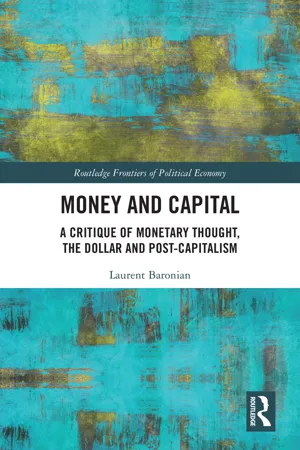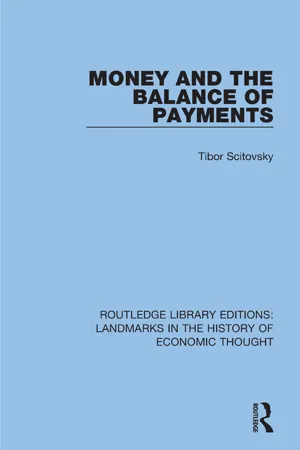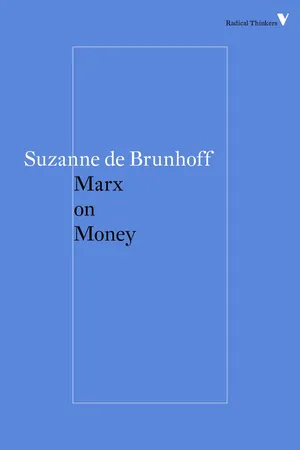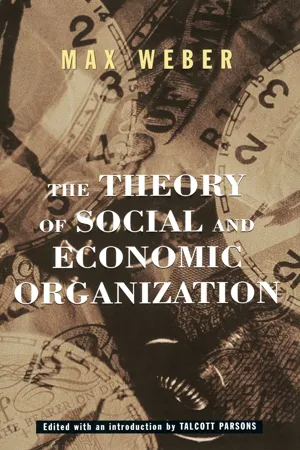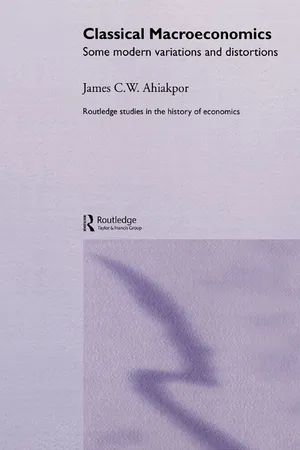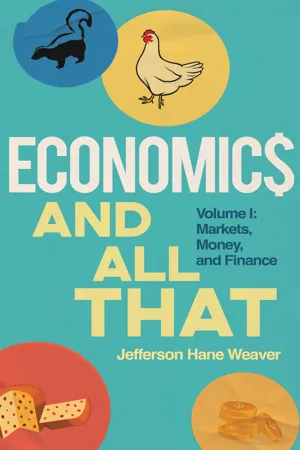Economics
Types of Money
Types of money refer to the various forms of currency and assets that are used as a medium of exchange in an economy. These can include physical forms like coins and banknotes, as well as digital or electronic forms such as bank deposits and cryptocurrencies. Money serves as a unit of account, a store of value, and a medium of exchange in economic transactions.
Written by Perlego with AI-assistance
Related key terms
10 Key excerpts on "Types of Money"
- eBook - ePub
Deciphering Markets and Money
A Sociological Analysis of Economic Institutions
- Jukka Gronow(Author)
- 2020(Publication Date)
- Helsinki University Press(Publisher)
It is a medium of exchange, a store of value, and a unit of account. If ‘money is what money does,’ one could well argue that in order for something to deserve to be called money it has to fulfill all three functions. 2 The standard economic theory of money concentrates on one of the functions: money as a means of exchange. In these theories, money comes into being as an unintended consequence of the economic rational reasoning of the individuals. 3 As Smith believed, in order to maximize their barter options, astute traders will hold in stock some of the most regularly exchanged commodities that they expect others will accept in the future in exchange for the goods they possess. Consequently, one of these, more or less gradually, and as if by chance, emerges from among all the myriad options on offer as the general media of exchange, mainly because of its advantageous material properties, such as durability, divisibility, and portability. In various historical periods, different kinds of valuables have acted as means of exchange, for instance, furs in the Novgorod Russia’s fur trade with Western Europe or huge stone rings in ancient Polynesia. Finally, a generally accepted coinage emerges, as if crystallized out of all available options, the value of which is based on the extraordinarily high value of precious metals. The general media of exchange, or money, allows for the natural process of barter trade to develop into more extensive and general exchange of commodities, and finally to a fully fledged market economy. In these mythical genealogies of money, the traders come to realize that their life would be much more convenient if they could trade with each other using a generally accepted commodity, money. Money is, in other words, invented and based on a social contract, as if men had in ancient times come together and agreed on the use of some particular commodity as their general means of exchange - eBook - ePub
Changing Face of Money
Will Electric Money Be Adopted in the United States?
- Barbara Ann Good(Author)
- 2014(Publication Date)
- Routledge(Publisher)
Money’s role as a medium of exchange, an essential function of money, also allows for productivity gains that result from specialization. For example, a farmer is generally better at growing crops than he is at trading crops and money allows him to use the proceeds from the sale of his crops to buy the goods and services he needs from a merchant, rather than involving him in numerous trades to achieve the same end. With money, the merchant can also buy the products that his customers want to buy, rather than merely offering them goods he was able to acquire through trades. Money allows people to specialize in what they are able to do most efficiently and effectively, rather than being traders.Once an object has come to be accepted as a medium of exchange, it takes on additional functions as well. The object will become the standard unit for quoting prices, and therefore provides the second principle role of money as a unit of account.5 This is also an essential characteristic of money as it makes little sense to quote prices except in the currently accepted medium of exchange.Money, as a store of value, is a possible, but not entirely necessary role. A store of value provides a means of storing wealth from one time period to another. When someone accepts money, they are doing so because they expect that the money can be “sold” at some future time for goods and services, while other commodities they could hold may not be used as readily. Money does not always fulfill this role, such as in times of high inflation or other currency devaluation. In addition, there are many stores of value other than money, and this function is not always included as a requisite for the conceptual definition of money.6Many different items have been used as money in different times and places, but a commodity was often used as the medium of exchange. The best commodities had three important qualities: the commodity was limited in supply, it was durable, and it could be divided into units that were sufficiently high in value so as not to require vast quantities of the commodity for the settlement of normal transactions. These characteristics were most generally present in precious metals, and thus precious metals were most often used as “commodity money.”7 - eBook - ePub
- John Smithin, John Smithin(Authors)
- 2002(Publication Date)
- Routledge(Publisher)
Representative Money’ (Keynes 1930:7). Commodity money is defined as ‘actual units of a particular freely-obtainable, non-monopolized commodity which happens to have been chosen for the familiar purposes of money’, or ‘warehouse warrants for actually existing units of the commodity’ (ibid.). Fiat money is representative money ‘which is created and issued by the State, but is not convertible by law into anything other than itself, and has no fixed value in terms of an objective standard’ (ibid.).Managed money is according to Keynes the most generalized form of money, which can:This is distinguished from managed money, which ‘is similar to Fiat Money, except that the State undertakes to manage the conditions of its issue in such a way that, by convertibility or otherwise, it shall have a determinant value in terms of an objective standard’ (ibid.: 8).—(Keynes 1930:8)degenerate into Commodity Money on the one side when the managing authority holds against it a hundred per cent of the objective standard, so that it is in effect a warehouse warrant, and into Fiat Money on the other side when it loses its objective standard.In other words, a full-bodied (say, one ounce) gold coin valued at one currency unit would qualify as commodity money, while a paper note which is convertible to gold against which a fractional gold reserve is held would qualify as managed money, even if the conversion rate is one currency unit per ounce of gold. Thus, a gold standard system can be operated as either a commodity money or as a managed money. On the other hand, a representative money can take the form of either a managed money (a paper note convertible on demand to gold, or even to a foreign currency as in a currency board system) or a fiat money (no promise to convert at a fixed exchange rate to precious metals or foreign exchange). Keynes argued that even a gold standard, whether a commodity or a managed money system, operates as a state money system. In either case, the state can always ‘rewrite the dictionary’, for example, by adopting a silver standard and a conversion rate (say, one ounce of gold for twelve ounces of silver). State money can be held by banks, by the central bank, and by the public: - eBook - ePub
Money and Capital
A Critique of Monetary Thought, the Dollar and Post-Capitalism
- Laurent Baronian(Author)
- 2022(Publication Date)
- Routledge(Publisher)
2This form of objectivity determines money in a mode of being that we should call the general form of value. Through the unity of these two modes of being of money, is expressed the nature of the commodity mode of production in which money is both the social form of the labour contained in commodities and the object of private appropriation for the exchangers. This is why “general equivalent” designates money as the objectified social form of the private labour of social individuals.3 The paradox of this dual mode is that it is as a private object that money fulfils its social function as a medium of exchange, while conversely it is as social wealth that money fulfils its private function as a store of value.When they try to define it, theorists of money usually first state the three generic functions of money – unit of account, medium of exchange or circulation, and store of value (Wicksell, Fisher, etc.) – before classifying them in order of historical appearance or practical importance, depending on the conception of the nature of money that they are trying to explain. But it never occurred to any economist, with a few exceptions (Aglietta and Orléan, 2002 ), that these functions contradict each other and manifest opposing dimensions of money. Thus, as a means of circulation, which orthodoxy makes the main function of money, money manifests itself as a form of general exchangeability, whereas the function of store of value refers to money as a general form of value. As a means of circulation, money fulfils a social function of distributing the products of society’s labour (Marx, 1857–58 : 131; 1859: 332). However, the trust in the social character of the production whose circulation is ensured by money makes it appear as “evanescent and ideal, something merely imaginative” (Marx, 1895: 568). Therefore, this function allows money to be replaced by any symbol of itself that society chooses by convention to best meet the requirements of this function (Campbell, 2004 : 84). However, while custom or convention is the source of the forms of money in circulation, it is never the source of the general equivalent character that money necessarily takes on in the market. Now, as a general equivalent, as the ultimate means of payment, as the general form of value, both its quantity and its materiality become essential (Marx, 1857–58 : 161–62).4 Thus, where the means of circulation fulfils a social function, money as a store of value presents itself instead as a private mode of existence of social wealth. Marx undoubtedly insisted a lot on the social virtues of this reserve function, which allows circulating money to find its channels of adduction and derivation, as required by variations in the value and quantities of circulating goods (Marx, 1859 - eBook - ePub
- Tibor Scitovsky(Author)
- 2016(Publication Date)
- Routledge(Publisher)
Part A MoneyPassage contains an image
Chapter 1 The functions of moneyMoney is a difficult concept to define, partly because it fulfils not one but three functions, each of them providing a criterion of moneyness, and partly because these criteria are fulfilled to different degrees by different assets. At best, moneyness is a matter of degree, with an arbitrary dividing line between money and non-money; at worst, one might get conflicting orderings of degrees of moneyness, depending on the criterion used. In any case, our first task is to discuss the three functions of money, which are those of a unit of account, a medium of exchange, and a store of value.A. THE UNIT OF ACCOUNTThe introduction of a unit of account in which to express and compare the values of different goods and services was as important for economic life as the invention of the wheel was for technology. A common unit of account is the sine qua non of the emergence of prices—market prices as well as the central planner’s shadow prices—and these are essential both for rational economic calculation and choice by the individual, and for transmitting economic information between individuals.A common unit of account, and prices expressed in such a unit, render comparable goods and services not otherwise comparable; and such comparability is apparently necessary if the individual’s choice is to be rational, in the sense of implying a transitive (i.e., non-contradictory) ordering of preferences. There is little information on this subject so far but some experimental evidence indicates that human choice often becomes intransitive in areas where it is not facilitated by a common unit of account.1 - eBook - ePub
Paper Money Collapse
The Folly of Elastic Money
- Detlev S. Schlichter(Author)
- 2014(Publication Date)
- Wiley(Publisher)
The skeptical reader may at this point still raise the following objections: First, the case is built on money’s function as the medium of exchange, but standard economic textbooks also ascribe other functions to money, such as a store of value or a unit for accounting and monetary calculation. Second, the changes in money’s purchasing power that result from changes in money demand could be disruptive, as they may impair money’s role as a basis for economic calculation. Maybe it is better to adjust the money supply in response to changes in money demand than to allow money’s price to change. This would make sure that money is a reliable tool for economic calculation. Third, if money production is not needed, how can we account for the growth in banking, which for a long time has included the issuance of money substitutes and fiduciary media, the latter meaning uncovered claims to money proper that are used by the public just like money, for example, demand deposits. How can we account for the fact that the world has moved away from commodity money of fixed supply to paper money of perfectly flexible supply?These are all good and valid questions. We will address each one of them in detail in the course of our investigation. At this juncture it may just be sufficient to make the following points.All additional functions that can be assigned to money are the result of money being the accepted medium of exchange. These functions, important as they are, are derivatives of the medium-of-exchange function. Because money is the medium of exchange and every good or service is traded against money, money prices are ideal for economic calculation. As to money being a vehicle for storing wealth, it is apparent that many other assets can be used for that purpose, too. Many of these have the additional attraction of potentially generating returns over time. Money does not offer any returns. It can therefore compete with other potential storages of wealth only by offering something special, and that is its universal acceptance in exchange for goods and services, its unique marketability, the ability to be exchanged for goods and services faster and more conveniently than any other asset. That, after all, is why it is money. So we are again back to the medium-of-exchange function of the monetary asset.Certain financial assets, in particular high-quality debt claims that are traded in very liquid markets, can sometimes become “near-monies,” and their owners may thus feel a reduced need to hold money proper. But these assets are fundamentally different in that they constitute simultaneously somebody else’s liability and therefore always carry an additional risk. Proper commodity money, such as gold, but also fiat money in the form of irredeemable paper tickets, is a financial asset that is not somebody else’s liability at the same time. The purchasing power of this money varies only with changes in the demand for money and, in the case of paper money, also with changes in its inherently flexible supply. We see here that the inflexibility of supply in the case of commodity money makes it a superior store of value. - eBook - ePub
- Suzanne de Brunhoff(Author)
- 2015(Publication Date)
- Verso(Publisher)
Thus one understands why Marx did not include in his theoretical exposition of the functions of money all the aspects of the power conferred by gold, but only those which are involved in the definition of money as a specific social relation. One can doubtless regret that Marx was not specific on this point; his analysis would have been more complete if he had given the reasons why it omitted certain elaborations. But one must not misinterpret these omissions, which are not lacunae, lest one fall into error subsequently in regard to the accumulation of money by capitalists and the role of banks and monetary policy.TABLE OF THE FORMS OF MONEYFunctions Formal Characters Laws of Simple Circulation Origin of the general equivalent. I. Measure of value.Commodity of variable value, without price. Determination of the prices of commodities inversely proportional, all other things being equal to the value of money. Standard of price. Weights of gold with a conventionally fixed “monetary price.” = money as “unit of account.” II. Medium of circulation.Value given, amount which circulates variable. Factors of circulation: price, mass of commodities that circulate, speed of circulation of money currency: —minted coins. Demonetization and gap between “monetary price” and “market price” of gold. Symbols of gold, although issued in arbitrary amount. —inconvertible fiat money. (Possible effects on the numerical variations of commodity prices.) I + II: Dematerialization of money III. Instrument of hoarding.Demand for money “in person” as universal equivalent. Absorption and preservation of the difference between the total money supply and money in circulation. Preservation of the form “general equivalent.” Monetary base of capitalist credit, and international transactions. - eBook - ePub
- Max Weber(Author)
- 2009(Publication Date)
- Free Press(Publisher)
From a formal legal point of view, paper money may consist in an officially redeemable certificate of indebtedness, acknowledged by a private individual, as in the case of the English goldsmiths in the seventeenth century, by a privileged bank, as in the case of bank-notes, or by a political body, as in the case of government paper. If it is effectively redeemable and thus functions only as a circulating medium or provisional money, it may be fully covered—thus constituting a certificate—or it may be covered only sufficiently to meet normal demands for redemption, which makes it a circulating medium. Coverage may be in terms of specified weights of bullion or of metal coin.It is almost always the case that paper money has first been issued as a redeemable form of provisional money. In modern times, it has been typically a medium of circulation, almost always in the form of banknotes. They have thus been denominated in terms of units of an existing metallic standard.1. Naturally the first part of the last paragraph is not true of cases where one form of paper money has been replaced by another; for example, where government paper has been replaced by bank-notes, or vice versa. But this is not a case of primary issue of money.2. It is of course true that means of exchange and of payment may exist which do not take a chartal form, as coins or notes or otherwise. There is no doubt of this. It is not, however, expedient to speak of these as ‘money,’ but, to use the term ‘unit of account’ or some other terms, which, according to the particular case, is appropriate. It is characteristic of money that it is associated with particular quantities of chartal objects. This is a property which is very far from being superficial or of secondary importance.If what has previously been provisional money has its redeemability suspended, it is important to distinguish whether the interested parties regard this as a temporary measure or as definitive for as long as they can predict. In the first case it would be usual, since metallic money or bullion is sought after for international payments, for the paper money to fall to a discount in relation to its nominal metal equivalent. This is not, however, by any means inevitable; and the discount is often moderate. The discount may, however, become large if the need for foreign exchange is very acute. In the second case, after a time a definite paper money standard will develop. Then it is no longer appropriate to speak of the monetary unit as discounted, but rather, as history tends to show, of devaluation. - eBook - ePub
- James C.W. Ahiakpor(Author)
- 2003(Publication Date)
- Routledge(Publisher)
He explains that money is “not only a medium of exchange, but…also…a measure of value. It serves as a means of comparing values of different things by expressing them both in a common denominator” (1912:18; italics in original). Also, “money is that particular kind of wealth in terms of which the value of all other kinds of wealth is measured” (5; italics in original). A.C.Pigou defines money in his 1917 restatement of the quantity theory of money in reaction to Fisher’s 1911 exposition of the equation of exchange alternative as “legal-tender money,” the value of whose unit, “like the value of everything else,” is determined by the “general conditions of [its] demand and supply” (1917:39, 40), very much in line with Marshall’s definition. In discussing the supply of money, Pigou refers to “currency” as well as “inconvertible paper notes” issued on the authority of government, and whose “supply curve…is obviously a vertical line fixed in whatever position the government may choose” (53–5). He also describes “bank notes and bank balances against which checks can be drawn” as “titles to legal tender” or “bank money” (42, 47, 60). Similarly, Pigou (1927) retains the distinction between legal-tender money (or currency) and bank money or checkable deposits, although sometimes applying the title money liberally to both, as in his claim that people hold their store of value “in the form of money—mainly, of course, bank-money” (121). Pigou later expands his definition of money to include other assets that may serve as media of exchange, reflecting elements of Fisher’s definition. Thus, he describes money as having “two divisions, current money and bank money,” where his “current money” includes Fisher’s “primary” and “fiduciary” monies, namely, “gold coins, token coins and Bank of England notes” (1949:6). But his “bank money” includes “bank balances… plus overdraft facilities” (ibid.; italics in original) - eBook - ePub
Economics and All That: Volume 1
Markets, Money, and Finance
- Jefferson Hane Weaver(Author)
- 2022(Publication Date)
- Armin Lear Press(Publisher)
Money and FinanceMoneyThere is nothing so sensuous as the feel of a newly minted bill. It has a smell that, when denominated in $50s or €50s or £ 50s, is of enormous appeal to essentially everyone—constituting a sort of “catnip” for human beings. And while lots of money may not buy happiness, it can usually be counted on to catch the attention of many people willing to tell you how great you are so long as they (your new-found sycophants) continue to be the willing beneficiaries of your personal philanthropy.Aside from boosting your chances to be the center of attention at any party, money also plays a central role in the function of all modern economic systems. It serves as a medium of exchange that enables people to avoid the clumsiness of trying to exchange wildly disparate goods and services in a barter economy. We recall from our reading of Nietzsche’s light-hearted Thus Spoke Zarathrusta (or maybe not) that the inherent difficulty of acquiring the goods you want and disposing of the goods you do not wish to keep is that you must engage in a needle-in-the-haystack search for a person who has the opposite desires of yours in wishing to dispose of something you want and acquire something you wish to sell in order to carry out a successful exchange.An illustration devoid of such densely abstruse verbiage will help to illustrate the difficulty of commerce in a barter economy. Suppose I am a merchant in 17th century London and I have a pig that I would like to get rid of due to my newly-discovered allergy to pork. But I would be very interested in acquiring a color television set for my home–even though the absence of electricity or, for that matter, broadcast programming of any kind, in preindustrial England would suggest that such a purchase would be foolish. I must somehow surmount the issue of the double coincidence of wants: I must find another individual who wishes to obtain a porcine companion and dispose of his color television set. As you can imagine, this situation poses a very difficult challenge. Even if we expand our potential pool of customers to include the millions of individuals living within the length and breadth of Merrie Olde England itself— each trying to acquire and dispose of a myriad of items— my task will be a daunting one.
Index pages curate the most relevant extracts from our library of academic textbooks. They’ve been created using an in-house natural language model (NLM), each adding context and meaning to key research topics.
